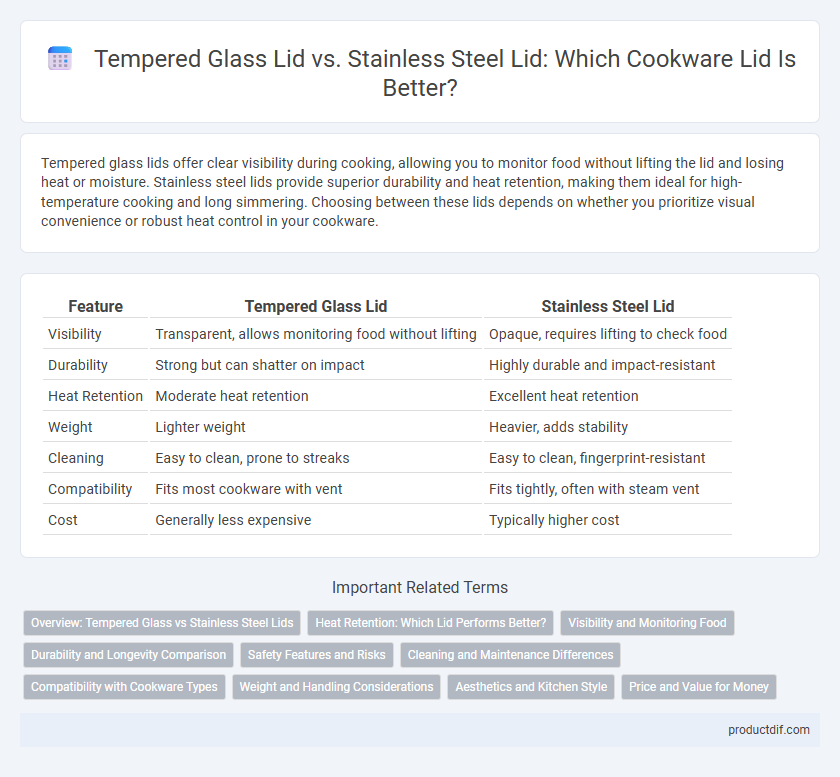Tempered glass lids offer clear visibility during cooking, allowing you to monitor food without lifting the lid and losing heat or moisture. Stainless steel lids provide superior durability and heat retention, making them ideal for high-temperature cooking and long simmering. Choosing between these lids depends on whether you prioritize visual convenience or robust heat control in your cookware.
Table of Comparison
| Feature | Tempered Glass Lid | Stainless Steel Lid |
|---|---|---|
| Visibility | Transparent, allows monitoring food without lifting | Opaque, requires lifting to check food |
| Durability | Strong but can shatter on impact | Highly durable and impact-resistant |
| Heat Retention | Moderate heat retention | Excellent heat retention |
| Weight | Lighter weight | Heavier, adds stability |
| Cleaning | Easy to clean, prone to streaks | Easy to clean, fingerprint-resistant |
| Compatibility | Fits most cookware with vent | Fits tightly, often with steam vent |
| Cost | Generally less expensive | Typically higher cost |
Overview: Tempered Glass vs Stainless Steel Lids
Tempered glass lids offer visibility during cooking, allowing users to monitor food without lifting the lid, which helps retain heat and moisture. Stainless steel lids provide superior durability, heat retention, and often fit more snugly, making them ideal for high-heat cooking and long simmering. Choosing between tempered glass and stainless steel lids depends on whether visibility or durability and heat retention are prioritized in cookware.
Heat Retention: Which Lid Performs Better?
Tempered glass lids allow for better heat monitoring without lifting the lid, but stainless steel lids generally provide superior heat retention due to their solid, non-transparent construction and thicker material. Stainless steel's dense composition helps trap heat and moisture more effectively, making it ideal for recipes requiring consistent and prolonged heat. Tempered glass lids may lose heat faster since they are thinner and less insulated compared to stainless steel lids.
Visibility and Monitoring Food
Tempered glass lids offer superior visibility, allowing cooks to monitor food without lifting the lid and losing heat or moisture. Stainless steel lids lack transparency, requiring removal to check the cooking process, which can disrupt temperature and prolong cooking time. Choosing tempered glass lids enhances control over cooking by providing clear visibility while maintaining consistent heat.
Durability and Longevity Comparison
Tempered glass lids provide excellent durability against thermal shock and allow for easy monitoring of food during cooking, but they can be prone to shattering if dropped. Stainless steel lids offer superior longevity with strong resistance to dents, scratches, and corrosion, making them ideal for heavy daily use. Choosing between them depends on whether visual cooking monitoring or maximum durability is the priority for your cookware needs.
Safety Features and Risks
Tempered glass lids offer the benefit of visibility while cooking, allowing for easy monitoring without lifting the lid, and they are designed to withstand high temperatures and sudden temperature changes, reducing the risk of shattering. Stainless steel lids provide superior durability and resistance to impact, with no risk of glass breakage, and often feature tightly sealed rims that enhance safety by preventing spills and heat loss. Both materials must be chosen carefully: tempered glass lids require cautious handling to avoid chips that can weaken the glass, while stainless steel lids can become extremely hot, necessitating the use of heat-resistant handles or gloves to prevent burns.
Cleaning and Maintenance Differences
Tempered glass lids offer ease of cleaning due to their smooth, non-porous surface that resists staining and allows visibility of the cooking process, reducing the need for frequent wiping. Stainless steel lids require more attention to prevent water spots and fingerprints, often needing polishing to maintain their shiny appearance. Both materials are dishwasher safe, but tempered glass lids typically demand less frequent maintenance to retain their clarity and cleanliness.
Compatibility with Cookware Types
Tempered glass lids offer excellent compatibility across various cookware types, allowing for easy monitoring of cooking progress without lifting the lid, which is ideal for pots and pans made from stainless steel, aluminum, and non-stick materials. Stainless steel lids provide a durable, heavy-duty option that fits securely on compatible cookware, especially on stainless steel and cast iron pots, ensuring better heat retention and moisture sealing. Choosing between tempered glass and stainless steel lids depends on the cookware type and cooking style, with glass lids suited for visibility and steel lids for enhanced durability and heat control.
Weight and Handling Considerations
Tempered glass lids are lighter than stainless steel lids, making them easier to lift and maneuver during cooking, which reduces strain on the wrist and hand. Stainless steel lids, though heavier, provide a sturdier feel and enhance durability, often preferred for long-duration cooking where weight is less of a concern. Choosing between the two depends on whether ease of handling or lid robustness is prioritized in cookware usage.
Aesthetics and Kitchen Style
Tempered glass lids provide a sleek, modern aesthetic with clear visibility, enhancing contemporary kitchen styles by showcasing cookware contents without lifting the lid. Stainless steel lids offer a classic, polished look that complements traditional or industrial kitchen designs, adding durability and a cohesive metal finish. Choosing between them depends on whether transparency or a timeless metallic appearance better aligns with your kitchen's overall aesthetic.
Price and Value for Money
Tempered glass lids typically cost less than stainless steel lids, offering the advantage of easy visibility while cooking, which enhances value for money due to their durability and scratch resistance. Stainless steel lids, though often priced higher, provide superior heat retention and durability, making them a cost-effective investment for long-term use in professional kitchens. Choosing between the two depends on prioritizing either affordability and cooking visibility or long-lasting heat efficiency and sturdiness.
Tempered Glass Lid vs Stainless Steel Lid Infographic

 productdif.com
productdif.com